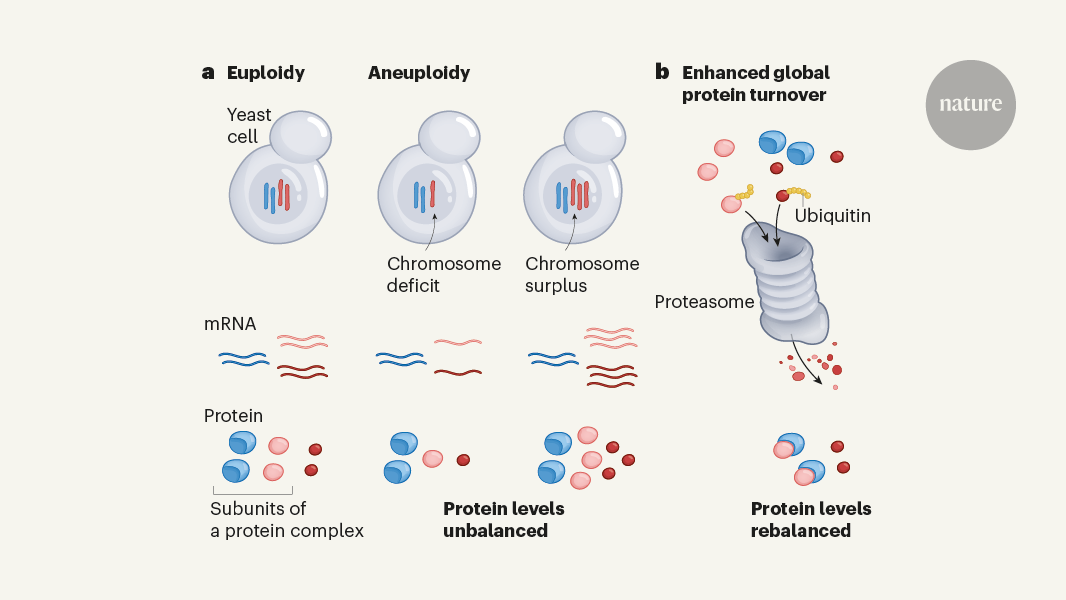Molecular Mechanisms Enabling Aneuploid Yeast Strains to Adapt and Thrive
Основные понятия
Aneuploid yeast strains have developed molecular mechanisms to cope with the proteotoxic stress and proliferative disadvantages caused by imbalances in gene expression and protein abundance.
Аннотация
The content discusses how organisms typically maintain a species-specific number of chromosomes (euploidy), but a condition known as aneuploidy, where cells have an incorrect number of chromosomes, also exists in nature. Aneuploidy leads to imbalances in gene expression and protein abundance, which can inflict a burden on cells in the form of proteotoxic stress and proliferative disadvantages, as observed in laboratory-engineered budding yeast strains.
However, aneuploidy can also be beneficial in varying environments, as the wide-ranging changes to the proteome can offer rapid adaptive solutions. In fact, aneuploidy is found in nearly 20% of naturally occurring yeast strains. The article by Muenzner et al. sought to uncover the molecular processes that allow these aneuploid yeast strains to thrive.
The key insights from the content are:
Euploidy, the species-specific number of chromosomes, is the norm, but aneuploidy, an incorrect number of chromosomes, also exists in nature.
Aneuploidy leads to imbalances in gene expression and protein abundance, causing proteotoxic stress and proliferative disadvantages in laboratory-engineered yeast strains.
Aneuploidy can also be beneficial in varying environments, as the changes to the proteome can offer rapid adaptive solutions.
Aneuploidy is found in nearly 20% of naturally occurring yeast strains, suggesting they have developed molecular mechanisms to cope with the challenges posed by an aneuploid genome.
The study by Muenzner et al. aimed to uncover these molecular processes that enable aneuploid yeast strains to thrive.
Cells cope with altered chromosome numbers by enhancing protein breakdown
Статистика
Aneuploidy is found in nearly 20% of naturally occurring yeast strains.
Цитаты
"Aneuploidy can also be beneficial in varying environments, in which wide-ranging changes to the proteome can offer rapid adaptive solutions."
"Aneuploidy is found in nearly 20% of naturally occurring yeast strains, for example."
Ключевые выводы из
by Zuza... в www.nature.com 05-22-2024
https://www.nature.com/articles/d41586-024-01360-6
Дополнительные вопросы
What specific molecular mechanisms do aneuploid yeast strains employ to cope with the proteotoxic stress and proliferative disadvantages caused by imbalances in gene expression and protein abundance?
Aneuploid yeast strains utilize several molecular mechanisms to manage the proteotoxic stress and proliferative disadvantages resulting from imbalances in gene expression and protein abundance. One key mechanism is the upregulation of protein degradation pathways, such as the ubiquitin-proteasome system and autophagy. These pathways help in clearing misfolded or excess proteins that accumulate due to aneuploidy, thereby reducing proteotoxic stress. Additionally, aneuploid cells may activate stress response pathways, such as the heat shock response, to enhance protein folding and stability. By modulating these pathways, aneuploid yeast strains can mitigate the negative effects of imbalanced gene expression and protein levels, promoting cellular survival and adaptation.
How do the adaptive advantages of aneuploidy in varying environments compare to the disadvantages in terms of cellular fitness and organismal survival?
The adaptive advantages of aneuploidy in varying environments stem from the ability of aneuploid cells to rapidly alter their proteome in response to changing conditions. This flexibility allows them to adapt to diverse environmental stresses or nutrient availability, providing a survival advantage in fluctuating habitats. However, these adaptive benefits come with trade-offs in terms of cellular fitness and organismal survival. Aneuploidy-induced proteotoxic stress and imbalances in gene expression can impose a burden on cells, leading to reduced proliferation rates and decreased fitness under certain conditions. While aneuploidy may confer short-term adaptive advantages, the long-term consequences on cellular health and organismal survival must be carefully considered.
How can the insights from understanding aneuploid yeast strains be applied to better understand aneuploidy in other organisms, including humans, and its implications for disease and evolutionary adaptation?
Insights gained from studying aneuploid yeast strains can provide valuable knowledge for understanding aneuploidy in other organisms, including humans, and its implications for disease and evolutionary adaptation. By elucidating the molecular mechanisms that enable yeast cells to cope with aneuploidy-induced stress, researchers can uncover conserved pathways and principles that may apply to higher eukaryotes. Understanding how aneuploidy affects cellular function and organismal fitness in yeast can inform studies on aneuploidy-related diseases in humans, such as cancer and developmental disorders. Moreover, insights into the adaptive potential of aneuploidy in yeast can shed light on the role of chromosomal instability in evolutionary processes and the emergence of genetic diversity in natural populations. By leveraging the knowledge gained from aneuploid yeast strains, researchers can advance our understanding of aneuploidy across species and its broader implications for health and evolution.
0
